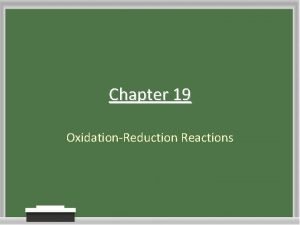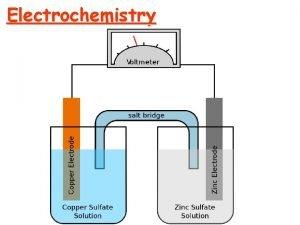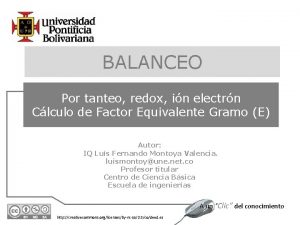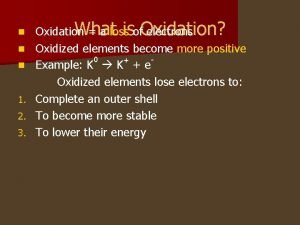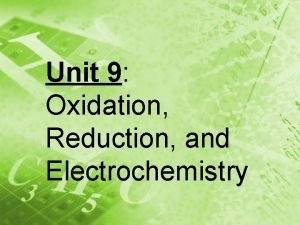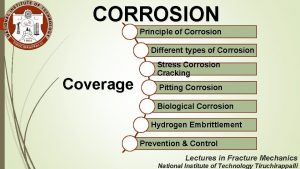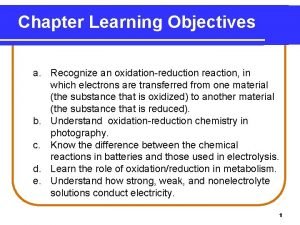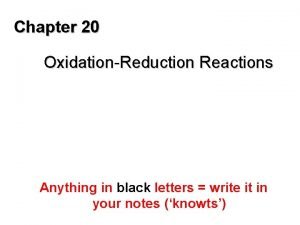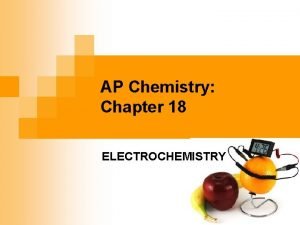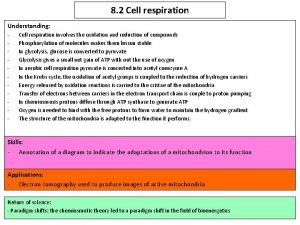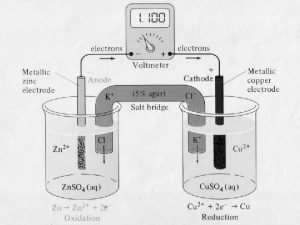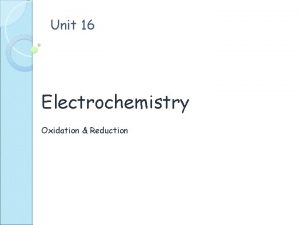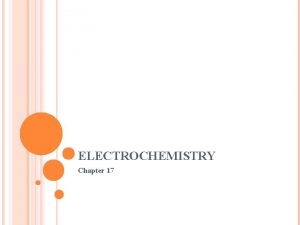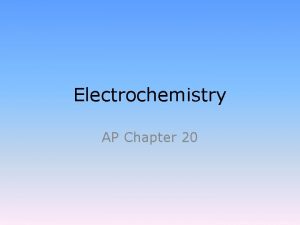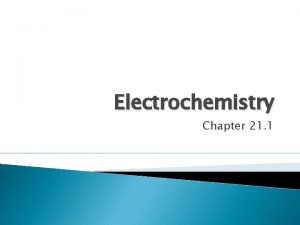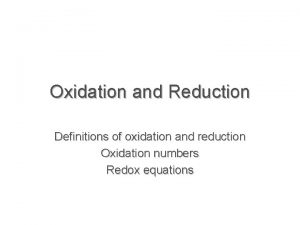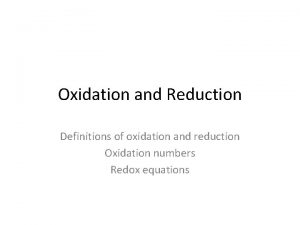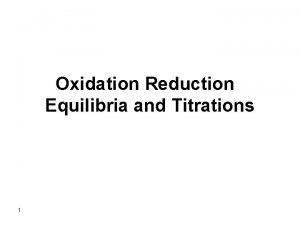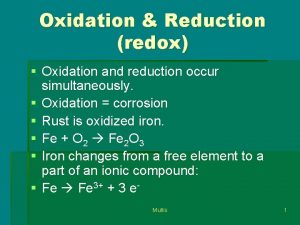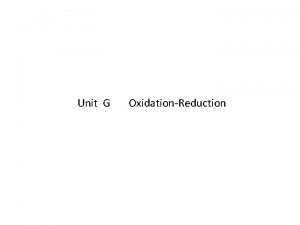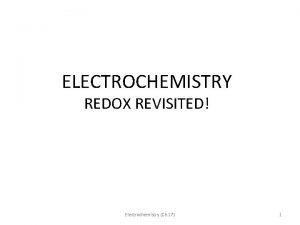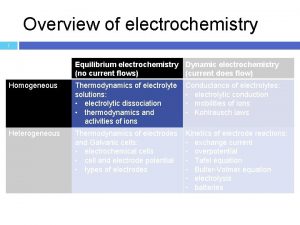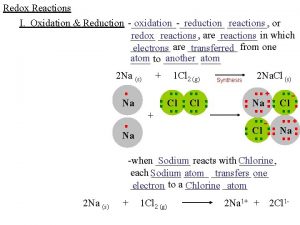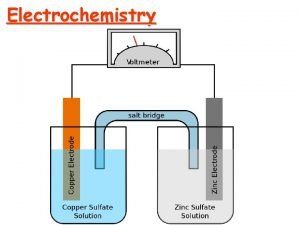Electrochemistry Chapter 18 Oxidation State and Oxidation Reduction


























- Slides: 26

Electrochemistry Chapter 18

Oxidation State and Oxidation. Reduction Reactions n Redox reactions are one of the reaction types covered in Ch. 4 ¡ ¡ n For the rules associated with assigning oxidation numbers see Pg. 149 Analogous to acid-base reactions Oxidant Reductant Ex: Zn(s) + 2 H+(aq) → Zn 2+(aq) + H 2(g)

Identifying Oxidizing and Reducing Agents Determine the oxidation numbers of the elements in the following reaction. Identify the oxidant and reductant. 5 H 2 C 2 O 4(aq) + 6 H 3 O+(aq) + 2 Mn. O 4 -(aq) → 10 CO 2(g) + 2 Mn+(aq) + 14 H 2 O(l)

Balancing Oxidation-Reduction Reactions n When balancing typical chemical reactions, mass must be conserved ¡ n However, charge must be conserved as well Redox reactions must be broken up into two half reactions which must be balanced separately ¡ Two half reactions: One for oxidation; one for reduction

Balancing Redox Reactions (cont. ) Two types of solutions: acidic and basic n ¡ Divide equation into two half reactions Balance each half reaction 1. 2. 3. 4. 3. 4. Rules are only slightly different All elements other than O and H Balance O by adding H 2 O Balance H by adding H+ Balance charge by adding electrons, e- Multiply each half reactions with integer values in order to balance the # of electrons Combine both half reactions

Redox Reactions in Acidic Solution Balance the following redox reaction which takes place in acidic solution: Fe 2+(aq) + Cr 2 O 72 -(aq) → Cr 3+(aq) + Fe 3+(aq)

Redox Reactions in Basic Solution n Exactly the same as acidic solution ¡ Only difference is that OH- must be used to “neutralize” H+ added to balance H’s n n No appreciable amount of H+ can exist in basic solution Ex: Mn. O 4 -(aq) + Br-(aq) → Mn. O 2(s) + Br. O 3 -(aq)

Galvanic Cells Section 18. 1 n Spontaneous redox reactions are used to perform electrical work using a voltaic cell ¡ Voltaic cells (sometimes called galvanic cells) require an oxidant and reductant and some sort of medium for the electrons to travel through in order to produce current

Voltaic Cell Diagram n Each half of the voltaic cell is referred to as a half-cell ¡ ¡ Current flow: anode to cathode Cathode Anode Overall Rxn: Zn(s) + Cu 2+(aq) Zn 2+(aq) + Cu(s)

Describing a Voltaic Cell Consider the cell shown below. a. ) Write the half-reaction that occurs in each half cell b. ) Write the equation for the overall chemical change taking place c. ) Identify cathode and anode d. ) Identify the signs of the electrodes e. ) Indicate the direction that the nitrate ions flow through the salt bridge

Cell EMF Under Standard Conditions Section 18. 2 n In a voltaic cell, there is a potential difference between the two electrodes (electromotive force or cell potential) ¡ ¡ For a spontaneous reaction Ecell will have a positive value Under standard conditions (1 M or 1 atm) it is referred to as standard cell potential, E cell

Standard Reduction Potentials n n In theory, we could experimentally determine the Ecell values for every possible redox combination (dumb idea—too much work) More practically, we can determine the voltage required for reduction to occur at an electrode ¡ Referred to as standard reduction potentials and are referenced to the standard hydrogen electrode (SHE) n E red = 0

Calculating Ecell n The cell potential, E cell, can be calculated using tabulated standard reduction potentials: E cell = E red(cathode) - E red(anode) n For all reactions, the reaction is spontaneous if E cell is positive ¡ The more positive the value, the more driving force there is for the reaction to occur

Standard Reduction Potentials

Calculating E cell from Standard Reduction Potentials Calculate the standard potential and See state the direction in which the Interactive reaction proceeds spontaneously for: Example 18. 1 (Pg. 711) 2 Cr+3(aq) + 2 Br-(aq) → 2 Cr+2(aq) + Br 2(l)

Determining Half-Reactions at Electrodes and Calculating Cell EMF A voltaic cell is based on a Co 2+/Co half cell and an Ag. Cl/Ag half cell. a. ) What half-reaction occurs at the anode? b. ) What is the standard cell potential? See Interactive Example 18. 2 (Pg. 713)

Relative Strengths of Oxidizing Agents

Free Energy and Redox Reactions Section 18. 3 n We know that a negative G value indicates a spontaneous reaction, and we also know that a positive emf, E, also indicates spontaneity Therefore there must be a link between the two: G = -n. FE or G = -n. FE (std. cond. ) F = Faraday’s constant = 96, 485 J/V mol n = # of electrons transferred in the reaction ¡

Determining G Calculate the standard free energy change for See the reaction below: Interactive Example 18. 3 (Pg. Ag. Cl(s) + Fe+2(aq) Ag(s) + Fe+3(aq) + Cl-(aq) 716)

Determining G and K Calculate the equilibrium constant for the reaction below: Sn 2+(aq) + Ni(s) Sn(s) + Ni 2+(aq)

Cell emf Under Nonstandard Conditions Section 18. 4 n Cell potential under nonstandard conditions can be calculated using the Nernst equation which is derived from the equation describing free energy change: G = G + RT ln(Q) Nernst equation:

Voltaic Cell EMF under Nonstandard Conditions A voltaic cell consists of a half-cell of iron ions in a solution with [Fe 2+] = 2. 0 M and [Fe 3+] = 0. 75 M, and a half-cell of copper metal immersed in a solution containing Cu 2+ at a concentration of 3. 6 x 10 -4 M. What is the voltage of this cell? See Interactive Example 18. 7 (Pg. 720)

Calculating Concentration in a Voltaic Cell What is the p. H of the solution in the cathode compartment of the reaction shown below when PH 2 = 1. 0 atm, [Zn 2+] in the anode compartment is 0. 10 M, and the cell emf (Ecell) is 0. 542 V? Zn(s) + 2 H+(aq) → Zn 2+(aq) + H 2(g)

Electrolysis Section 18. 7 n Voltaic cells take advantage of spontaneous electrochemical reactions to produce electrical current ¡ The exact opposite occurs during electrolysis

Quantitative Aspects of Electrolysis n Consider the reactions below: Li+ → Li(s) Mg 2+ → Mg(s) n If the amount of charge applied to an electrolytic cell is known, the mass of the electroplated material can be calculated Coulombs = amperes x seconds

Relating Electrical Charge and Quantity of Electrolysis A constant current of 0. 500 A passes through a silver nitrate solution for 90. 0 minutes. What mass of silver metal is deposited at the anode? See Interactive Example 18. 9 (Pg. 730)
 Chapter 19 review oxidation-reduction reactions
Chapter 19 review oxidation-reduction reactions Reducing agent strength table
Reducing agent strength table How to write reduction half reactions
How to write reduction half reactions Oxidation half reaction
Oxidation half reaction Nernst equation simplified
Nernst equation simplified Balancing oxidation reduction reactions
Balancing oxidation reduction reactions 2kclo3 2kcl 3o2 oxidation and reduction
2kclo3 2kcl 3o2 oxidation and reduction Reduction definition chemistry
Reduction definition chemistry Differentiate between oxidation and reduction
Differentiate between oxidation and reduction What isof
What isof Which identifies an oxidation-reduction reaction?
Which identifies an oxidation-reduction reaction? Oxidation-reduction quiz
Oxidation-reduction quiz Electron transfer in redox reaction
Electron transfer in redox reaction Leo goes ger
Leo goes ger Redox examples
Redox examples Soft bender rod
Soft bender rod Leo the lion says ger
Leo the lion says ger What is corrosion
What is corrosion Oxidation–reduction reactions
Oxidation–reduction reactions Leo and ger
Leo and ger Leo the lion says ger
Leo the lion says ger Leo the lion goes ger
Leo the lion goes ger Chemistry
Chemistry Oxidation reduction
Oxidation reduction Red cat redox
Red cat redox Kh oxidation number
Kh oxidation number Anode oxidation
Anode oxidation


